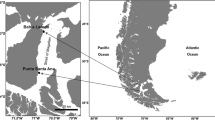Abstract
The effects of a sudden, extraordinary temperature rise upon a soft-bottom community in the northern Baltic Sea were studied continuously for more than a month, during the summer of 1968. The mean bundance of the total macrofauna on the muddy bottom amounted to ca 6×103 individuals · m-2, on the sandy bottom to 2×104 individuals· m-2. The meiofauna, only sampled in the mud, averaged 1×106 individuals · m-2, with nematodes, oligochaetes and ostracods as dominating groups. During this period, the redoxpotential-discontinuity (RPD)-layer successively moved upwards in the muddy bottom, being relatively stable in the sand. The mud surface showed a succession of microbial communities. The initially oxidized, yellow surface film, with patches of diatoms and red Spirula, changed to a more grayish layer, with purple areas here interpreted as Chromatium and white spots of Beggiatoa. The latter dominated during the last part of the period, covering vast areas of the bottom like a gigantic cobweb. The endofauna was forced upwards by the emerging RPD-layer, the more sensitive components dying off, facultative anaerobes and nematodes flourishing. The described temperature increase of about 10 C° simulates the effects of a 3000 MW nuclear plant.
Similar content being viewed by others
Literature Cited
Elmgren, R.: A comparison of different methods of sampling the meiofauna of sublittoral soft bottoms. Oikos (Suppl.) 14 (1973). (In press).
Fenchel, T.: The ecology of marine microbenthos. I. The quantitative importance of ciliates as compared with metazoans in various types of sediments. Ophelia 4, 121–137 (1967).
—: The ecology of marine microbenthos IV. Ophelia 6, 1–182 (1969).
— and B. O. Jansson: On the vertical distribution of the microfauna in the sediments of a brackish-water beach. Ophelia 3, 161–177 (1966).
— and R. J. Riedl: The sulphide system: a new biotic community underneath the oxidized layer of marine sand bottoms. Mar. Biol. 7 255–268 (1970).
Golikov, N. and O. A. Scarlato: Ecology of bottom biocoenoses in the Possjet Bay (in Sea of Japan) and the peculiarities of their distribution in connection with physical and chemical conditions of the habitat. Helgoländer wiss. Meeresunters. 15, 193–201 (1967).
Hallberg, R. O.: Some factors of significance in the formation of sedimentary metal sulphides. Stockh. Contr. Geol. 15, 39–66 (1967).
Hopkins, T. L.: A survey of marine bottom samplers. Prog. Oceanogr. 2, 213–256 (1964).
Jansson, B. O.: The availability of oxygen for the interstitial fauna of sandy beaches. J. exp. mar. Biol. Ecol. 1, 122–143 (1968).
—: Factors and fauna of a Baltic mud bottom. Limnologica, 7, 47–52 (1969).
Krenkel, P. A. and F. L. Parker: Biological aspects of thermal pollution, 407 pp. Portland, Oregon: Vanderbilt University Press 1969.
Kosler, A.: Distributional patterns of the eulitoral fauna near the isle of Hiddensee (Baltic Sea, Rugia). Mar. Biol. 1, 266–268 (1968).
Petersen, C. G. Joh.: Havets bonitering II. On havbundens dyresamfund og om disses betydning for den marine zoogeografi. (Valuation of the sea II. The animal communities of the sea bottom and their importance for marine zoogeography) [Danish]. Beretn. Minist. Landbr. Fisk. dan. biol. Stn 21, 1–44 (1913).
Pringsheim, E. G.: Heterotrophism and species concepts in Begiatoa. Am. J. Bot. 51, 898–913 (1964).
Purasjoki, K.: Quantitative Untersuchungen über die Mikrofauna des Meeresbodens in der Umgebung der Zoologischen Station Tvärminne an der Südküste Finnlands. Commentat. biol. 9, 1–24 (1945).
Särkkä, J.: The bottom fauna at the mouth of the river Kokemäenjoki, southwestern Finland. Ann. Zool. Fennici 6, 275–288 (1969).
Wieser, W.: Biotopstruktur und Besiedlungsstruktur. Helgoländer wiss. Meeresunters. 10, 359–374 (1964).
Wood, W. J. F.: Marine microbial ecology, 243 pp. London: Chapman & Hall Ltd. 1965.
Author information
Authors and Affiliations
Additional information
Communicated by B. Swedmark, Fiskebäckskil
Rights and permissions
About this article
Cite this article
Ankar, S., Jansson, B.O. Effects of an unusual natural temperature increase on a baltic soft-bottom community. Marine Biology 18, 9–18 (1973). https://doi.org/10.1007/BF00347915
Accepted:
Issue Date:
DOI: https://doi.org/10.1007/BF00347915




